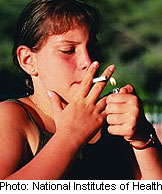
THURSDAY, May 17 (HealthDay News) — Smoking rates among American teens and young adults fell between 2004 and 2010, but too many of them still light up, a new federal government report reveals.
The rate of current cigarette use among U.S. teens decreased from nearly 12 percent in 2004 to about 8 percent in 2010, and dropped from nearly 40 percent to about 34 percent among young adults, according to the analysis from the Substance Abuse and Mental Health Services Administration’s National Survey on Drug Use and Health released Thursday.
The percentage of daily smokers among teens fell from just over 3 percent to under 2 percent, and decreased from about 20 percent to nearly 16 percent among young adults during the study period, the survey found.
Among young adults who were daily smokers, the percentage who smoked 26 or more cigarettes a day (about 1½ packs or more) was nearly halved, from 6 percent in 2004 to 3.4 percent in 2010. Meanwhile, many seemed to be cutting back on how much they smoked, with the percentage of young adults who smoked five or fewer cigarettes per day rising from about 24 percent to 28 percent.
“Although some progress has been made in curbing youth smoking, the fact remains that one in 12 adolescents currently smoke and one in three young adults smoke — which means that far too many young people are still endangering their lives,” SAMHSA administrator Pamela Hyde said in a government news release.
“As the recently released Surgeon General’s Report on Preventing Tobacco Use Among Youth and Young Adults notes, smoking is the nation’s leading cause of preventable death and we must take every opportunity to prevent kids and young adults of today from becoming the hooked, ailing adult smokers of tomorrow,” she added.
The surveys included more than 150,000 people aged 12 to 17 and nearly 160,000 people aged 18 to 25.
SAMHSA also noted that the average national retailer rate of illegal sales of tobacco products to underage youth is down to 9.3 percent, the lowest level in the 14-year history of a program targeting such sales.
More information
The U.S. Centers for Disease Control and Prevention has more about youth and tobacco.

